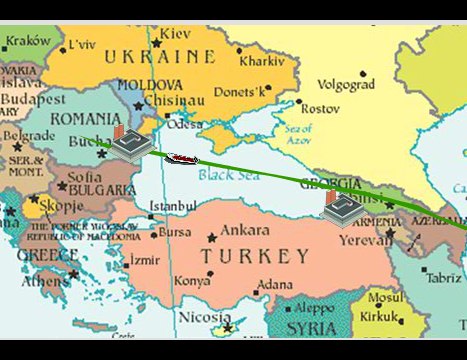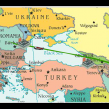
Why Is AGRI Back on Europe’s Energy Security Agenda?
Publication: Eurasia Daily Monitor Volume: 12 Issue: 132
By:

The Azerbaijan-Georgia-Romania Interconnector (AGRI)—a liquefied natural gas (LNG) project, which aims to bring Azerbaijani gas and, in the future, gas from Turkmenistan to Romania and Hungary by way of Georgia and across the Black Sea—was at the center of attention of regional decision makers late last month. In particular, an AGRI Ministerial Meeting was held in Bucharest, on June 24, where a joint declaration of support was signed by the countries party to this project (Trend.az, Azertag, June 24).
The transport system of the AGRI LNG project proposed by the stakeholders is to ship gas from Azerbaijan to the Georgian coastal port of Poti through the South Caucasus Pipeline Expansion (SCPx). The gas will then be liquefied at a new terminal in Poti and shipped via tankers from Poti to the Romanian port of Midia, where this LNG will be gasified at a new re-gas terminal and transported through new pipelines to Romanian, Hungarian and other potential European markets. Construction of a new pipeline from Midia further inland into Romania and Hungary will be needed.
For the stakeholders of the project, its potential sponsors and the affected market participants, this project promises to have strategic and economic benefits. From a strategic perspective, AGRI’s value comes from its unique project geography. Several other transportation projects initiated to bring gas to the European market from Russia (Turkish Stream) and Azerbaijan (The Southern Gas Corridor—SGC) are currently also in various planning or construction stages. One connecting feature of these two—as well as other potential projects that promise to deliver more gas to Europe from alternative sources, including Turkmenistan, Iran, Iraq and the Eastern Mediterranean—is that all these proposed pipelines are to pass through Turkey. Furthermore, sole reliance on a single pipeline system raises concerns about security of supply. Within this context, therefore, AGRI should be viewed as the only alternative transportation project that will not only bring gas from a new source (non–Shah Deniz gas) but also as the only project with a truly alternative dedicated route—thus decreasing the dependence on one transit country or a single pipeline system. This should be considered AGRI’s main strategic value for gas producers in Azerbaijan and the Caspian region, as well as for European gas buyers.
The economic value of the project will be high for stakeholders and sponsors if the unit transport cost of gas transportation through AGRI—which includes liquefaction, shipping and regasification—ends up being lower than the unit cost of pipeline transportation, for instance through the SGC. To make AGRI attractive to investors, the project would need to ensure a recovery of investment. But given the fact that in addition to the pipeline shipping costs, two expensive facilities (liquefaction and re-gas terminals) will first need to be built, it may at first seem that the project cannot be justified on an economic basis compared with the similar but solely pipeline-based projects being considered and employed. However, when evaluating the AGRI project in relation to other planned means of transporting Caspian gas to Europe—such as by analyzing the cost of the project, based on the publicly available figures, against the cost of, for example, the SGC—AGRI may be regarded as a commercially viable project.
Preliminary estimates shows that, the cost of the project will vary from $2 billion to $5 billion, depending on the capacity of the terminals, which could equal 2, 5 or 8 billion cubic meters per year (bcm/y) (Azernews, June 25; Adevarul.ro, June 24). The SGC’s total construction cost, which includes SCPx, the Trans-Anatolian Pipeline (TANAP) and the Trans-Adriatic Pipeline (TAP), is estimated at $25 billion–$27 billion, for transporting 16 bcm of gas at the first stage (“Project Timeline,” Bp.com, accessed July 14). Whereas the cost of the AGRI project for similar gas volumes would be $9 billion. The overall viability of this gas supply project will depend on the results of the transportation unit cost through the SCPx, the unit cost of liquefaction, its transportation across the Black Sea (via tankers), the regasification cost, and the unit cost of transportation of the gas from the regasification plant to European markets. Along with the overall shipping cost, the difference between European gas sale prices and the costs of Caspian-region gas is of high significance in achieving a final investment decision (FID).
The financing of AGRI, including the funding of operational (OPEX) and capital expenditures (CAPEX), remains a central issue for project partners. Many reasons exist for why this project deserves to be included on the list of the European Union’s Projects of Common Interest (PCI) and partly financed by EU institutions. First, it meets the EU’s long-term strategy and PCI requirements to bring more gas to Europe from alternative sources, as part of the SGC. Any non–Shah Deniz gas in Azerbaijan that can be a potential source for the AGRI project—including Absheron, Azeri-Chirag-Guneshli (ACG) non-associated gas, Umid/Babek etc.—should be viewed as an alternative source, as these fields and blocks will be operated by another consortium; and gas from Turkmenistan also should not be ruled out. Second, AGRI could mitigate any risks of European consumers becoming dependent on one transit country (Turkey, for instance) or a single pipeline system. Third, AGRI’s planned gas volumes (5–8 bcm) are large enough to make a difference in Romania, Hungary and, in the future, other potential countries in Eastern and Central Europe as well as the Balkans, given their small market sizes. Indeed, Bulgaria and Serbia have already expressed interest in the project (Adevarul.ro, June 24). The AGRI project could also serve Ukraine either via gas swaps or reverse flows through the existing pipeline from Hungary, or even by sending LNG volumes from the Romanian port to a future liquefaction facility planned for the Ukrainian port in Odesa.
Although the AGRI project needs further refinement and development, achieve a FID, and secure needed binding agreements as well as inter-governmental agreements (IGA) and host-government agreements (HGA), it seems that the timing could not be better to develop the project. All such similar projects—Nabucco-West, South Stream and White Stream—that would have served the same country markets have been abandoned for a variety of reasons. The large investment in the AGRI project should not be an obstacle to progress, as gaining deep and widespread political support can help to overcome such financial challenges.




